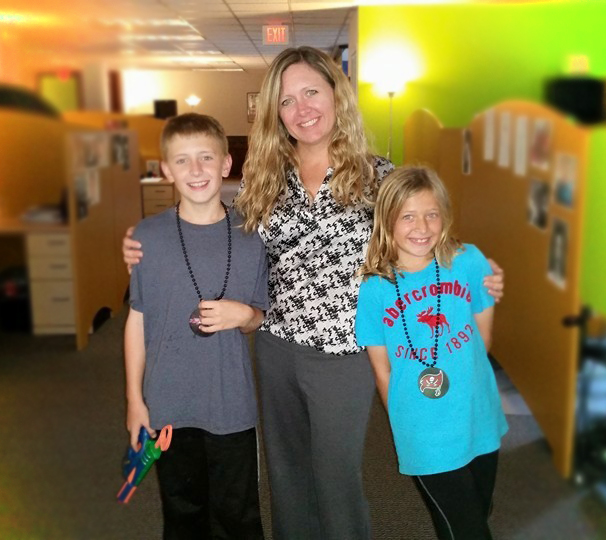Blog
10 Invaluable Books for Instructional Design
by Angel Green, senior instructional strategist | @LearnerAdvocate Last week, in the US, we celebrated the annual Take Our Daughters and Sons to Work ...


The World of e-Learning Design Through a Child
By Angel Green | May 01, 2015 | Custom Learning | 0 Comments
by Angel Green, senior instructional strategist | @LearnerAdvocate

Last week, in the US, we celebrated the annual Take Our Daughters and Sons to Work Day (http://www.daughtersandsonstowork.org/) and for the first time, I participated. Well, I participated with two of my three children and until just after lunch. That was about all of a day any of us, or my coworkers, could handle.
For those who aren’t aware, Take Our Daughters and Sons to Work Day is a national event that started over 20 years ago under the title of Take Our Daughters to Work Day. The concept is for parents to take their children (ages 8-18) to work for the day. During the day, they will observe the work parent does, meet the people with whom their parent works, and most importantly open their horizon of potential jobs.

For my oldest, who is 10 and in the fourth grade, he already had a sneak peek of what I do. Earlier this year, I participated in “career day” in which parents or other adults share their work with the entire class for 30-60 minutes each. During my 60 minutes, I had 18 fourth graders helping me sketch an e-learning design for a course. The topic was one in which they are all potential learners…how to make a peanut butter and jelly sandwich.
In the class, I walked them through similar questions I ask during a Savvy Start when trying to understand the CCAF elements for performance-based e-learning:
- Where do you make the sandwich?
- What does that space look like?
- What kind of mistakes can you make?
- How do you know if you’re successful?
- Walk me through the process.
Sketching is Fundamental
On the whiteboard, we drew a kitchen with a TV in the adjoining family room with cartoons playing loudly and a couple of hungry neighborhood kids anxiously awaiting their sandwiches. We talked about the challenge and drew some kids upset that their sandwich had crust, or crunchy peanut butter, or holes in the bread cause (as every fourth grader knows) it’s hard to spread on peanut butter.
The thing I find fascinating about children is the vision with which they look at the world. Without all the bias of taking previous training classes before, they were able to focus on the performance and work collectively to create a really cool, engaging learning experience.
Why was the TV on in the adjoining room? Because, like my son, several of the students in the class admitted to making mistakes when trying to cook, or pour a drink, or do anything really, due to the distraction of the TV. How brilliant is that! It’s not just that spreading chunky peanut butter onto white bread without tearing the bread is hard, but there are outside influences that also cause you to make mistakes. Without them telling me that, I wouldn’t have thought to put it in the design. (Well, maybe I would have because I am a mother and am aware of the ease of distraction for 10-year old boys!)
The Dangers of Experience
Comparing the experience of the children in class to a Savvy Start, I find myself saddened a little. I can almost tell you what most corporate training on the same subject would look like.
First, you’d be presented with content about each of the ingredients. The difference between the bread types, the benefits of the crust, the difference between the peanut butter types, the origin of peanuts, the potential for allergies and the alternatives to offer for those allergic, the difference between jam and jelly, the dangers of high fructose corn syrup, etc. Wake up, answer these questions, and move to the next section.
Next, you’d learn about the materials necessary to assemble the sandwich and the safety warnings for knife usage. You’d likely watch as someone spread the peanut butter too hard and ripped the bread. Then, you’d watch the right way to spread peanut butter to avoid ripping. Still alive? Pulse check question.
Finally, you’d be asked to complete a multiple choice question on the history of the peanut, the dangers of the knife, the percentage of sugar between jelly and jam, and the consequences possible if you push too hard while spreading the peanut butter. After scoring 80% you get your PB&J Sandwich Certification.
The Key to Performance Change Is To Focus On “Doing”
It doesn’t have to be this way! As instructional designers, we can work to get grown-ups to focus on performance. We just need to know how to separate what the learner needs to know versus what they need to do. Then, we work to brainstorm instructional treatments focused on the “do” and we leave the “know” for information sharing. Facilitating these discussions isn’t easy, which is why we dedicate so much time and effort in our books, blogs, workshops, and webinars on sketching and prototyping in the Savvy Start.
It takes practice to facilitate conversations that shift from the sequencing and scoping of content to brainstorming challenge-based instructional moments. This is why I highly encourage instructional designers to attend the ATD Leaving ADDIE for SAM MegaWorkshop. In this two-day course, we run through a mock Savvy Start and other mini-exercises to provide attendees the benefit we hope all learners get—an opportunity to practice and fail in the safe environment of training. We have a few spaces left in our upcoming workshops, so if you are interested, I encourage you to register quickly!
Want to share this post? Click to share these tweets!
Click to Tweet: @learneradvocate facilitates an #elearningdesign sketching exercise with children @customelearning http://hubs.ly/y0LMtz0
Click to Tweet: Children reveal their brainstorming creativity for performance-based e-learning with @learneradvocate #sketching @customelearning

About the Author: Angel Green
Angel Green is a senior instructional strategist for Allen Interactions’ Tampa studio, where she is responsible for providing consultation and instructional design expertise to clients, partnering to build engaging, interactive learning experiences. With nearly 15 years of experience, Angel has worked for organizations such as IBM, MetLife, and PricewaterhouseCoopers, and holds both MS and BS degrees from Florida State University. An accomplished speaker, Angel has held positions as an adjunct instructor of public speaking and is past president of a Toastmasters International chapter. She also frequently blogs on Allen Interactions’ e-Learning Leadership Blog. Angel is the co-author of the Leaving ADDIE For SAM Field Guide. Find Angel on Google+.
Comments
Would you like to leave a comment?
Related Blog Posts

By: Angel Green | Aug, 2014
Category: Custom Learning

Blog
10 Reasons Why You Should Attend the Allen Interactions User Conference
by Angel Green, senior instructional strategist | @LearnerAdvocate Last week, in the US, we celebrated the annual Take Our Daughters and Sons to Work ...
By: Angel Green | Jul, 2014
Category: Custom Learning, Digital Engineering, Strategic Consulting

Blog
Iterative e-Learning Development: SAM Uncovered
by Angel Green, senior instructional strategist | @LearnerAdvocate Last week, in the US, we celebrated the annual Take Our Daughters and Sons to Work ...
By: Angel Green | Apr, 2014
Category: Custom Learning, Strategic Consulting


